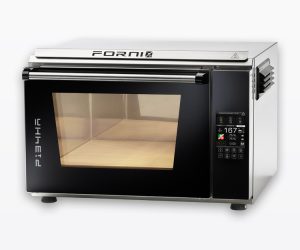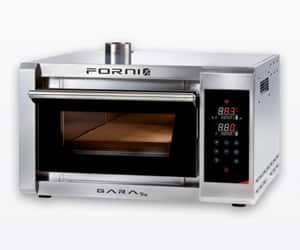Maintenance and Support
I NEED ASSISTANCE, HOW CAN I CONTACT YOU?
All assistance requests can be made through our virtual assistant (click here to request assistance).
THE OVEN DOES NOT TURN ON IN ANY WAY (INDICATOR LIGHTS OFF AND INNER CHAMBER LAMP OFF), WHAT SHOULD I DO TO FIX IT?
Check that the plug is inserted correctly, making sure it is placed properly.
Should the oven fail to turn on at all (even after checking the plug), try the following steps:
- Locate the red button on the back of the oven
- Press the button forcefully (until you hear a “click”)
- Press the on/off button of the oven.
Should the oven not turn on, despite following the procedure, we recommend contacting our virtual assistant (click here to request assistance)
HOW CAN OVEN CLEANING BE CARRIED OUT?
Always remove the plug from the power outlet before any cleaning. Never immerse the device in water;
Do not wash it under a jet or spray of water; you may compromise its electrical safety.
Always use a damp sponge or cloth to clean the outer surface. Avoid using abrasive products that will damage the surface. Be careful so that no water or liquid soap gets inside the oven louvers. When cleaning the inside of the oven, never use corrosive products (canister cleaners) and do not scratch the walls with sharp or pointed objects.
Never clean the heating elements.
Important: For your safety, cleaning should always be done when the oven is cold and disconnected from power.
SHOULD A SPECIAL PROCEDURE BE CARRIED OUT WHEN FIRST TURNING ON THE OVEN?
Read the Operation and Maintenance Manual received with the oven. Completely remove the laser film that protects the kiln and the polystyrene/carton block in the firing chamber that blocks the refractory stone (check that no small residue remains). Before the first use, run the device on no-load for at least 30 minutes to eliminate the “new” smell and some smoke due to the first lighting of the heating elements. During this operation ventilate the room appropriately.
The following, is the break-in procedure recommended by several users: With the original oven: set the thermostats to 150°C, with the thermostat lights off, leave it like that for 10′, turn off the switch and let it cool a bit. Repeat the same procedure at 250 – 350 and 450 (or 500 for the limited edition) degrees (in this last step, do not reset the thermostats -you will do it when cold-, turn off the switch, leave the door open wide a crack and never remove the plug from the socket, you will do it when the oven is cold). Replaced the original stone with the Biscuit (if supplied), turn the oven to 200°C and leave it like this for about ten minutes just to check that there is still no moisture inside. This “break-in” procedure is recommended but nevertheless not essential.
THE LOWER THERMOSTAT BULB IS ATTACHED ONLY TO ONE CLIP AND THE SECOND INNERMOST ONE IS LOOSE, IS THIS AN ASSEMBLY ERROR?
No, it is deliberately put that way to get the maximum lifetime of the thermostat component.
MY OVEN ARRIVED WITH A DETACHED PROBE INSIDE THE CHAMBER, HOW CAN I FIX IT?
Simply reposition it in the pressure clips in a simple operation.
THE FIRING CHAMBER AFTER A WHILE BECAME DARK, IS THIS NORMAL?
Yes it is normal, the prohibitive temperatures used to cook the pizza make the steel darker, it is not impossible that stains may also appear but they are not a symptom of non-compliance of the materials, one should try to dirty as little as possible.
THE LOWER THERMOSTAT "CYCLES" IN A VERY DIFFERENT WAY FROM THE UPPER THERMOSTAT, IS THIS NORMAL?
Yes, by running the lower resistor which has less than half the power of the upper resistor, it takes much longer to reach maximum temperature and has a very different operating behavior from the upper resistor.
The upper resistor is not perfectly in place, is this a serious problem?
Absolutely not, having a highly articulated development path it is possible that it may not be perfectly level, however, it is possible.
THE COOKIE LOOKS QUALITATIVELY VERY ROUGH AND WRINKLED, IS THIS NORMAL?
Yes, being a homemade production the cookie has an optimal functionality that prevents the bottom burn of the pizza at high/very high temperatures but aesthetically it is not very beautiful/finished well.
WHERE SHOULD THE SPECIAL COOKIE REFRACTORY STONE BE PLACED?
The cookie should be placed in place of the standard refractory stone provided. To be able to replace such a stone, one will simply need to use some flat tool ( e.g., even a knife ) to be able to pry off obliquely ( and gently ) the standard refractory stone.
Once the standard refractory stone is removed, the cookie can be inserted really easily.
HOW CAN THE CLEANING OF THE REFRACTORY STONE OR COOKIE BE DONE?
In order to carry out the cleaning, we recommend that the oven be turned on at maximum temperature (without dishes inside but only with cookie or refractory stone), so that any and all possible residues can be charred. After that, when the oven is completely cold, a damp cloth/scraper can be used to be able to remove the charred residue.
CAN THE OVENS ALSO BE RECESSED? NEED A MINIMUM SPACE FOR THERE TO BE PROPER FUNCTIONING?
Our professional ovens are not built-in, so we recommend leaving at least 12 to 15 cm around the sides ( left, right and top ) of the oven so that there is always proper ventilation.
CAN OVENS BE PLACED AND LEFT OUTDOORS?
All ovens are indoor only, so it is absolutely not recommended to use or leave the ovens outside (such as balcony, porch or garden).
THE BULB IS DAMAGED/NOT WORKING, HOW CAN I REPLACE IT?
In order to replace the room lighting lamp, follow the following procedure:
- Unscrew the round cover
- Remove the lamp carefully
- Insert the new lamp into the appropriate slot
- Screw the cover back on as in the initial position
The lamp can be purchased in the Replacement Parts section of the site effeuno.biz.






